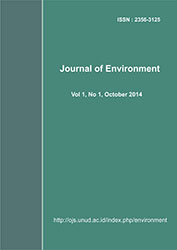Predicting Flood Vulnerable Areas by Using Satellite Remote Sensing Images in Kumamoto City - Japan
Abstract
Flood is a natural disaster that occurs almost every year in Japan. Based on the flood record, it occurs during the rainy season around July each year. The aim of this research is to predict areas vulnerable to flood. The current research location is the Shiragawa watershed. This study was carried out using DEMs data, ALOS AVNIR-2 and Amedas data to produce watershed area, vegetation index, land cover map and isohyet map. DEM data with spatial resolution of 10 meters was derived from the Geospatial Information Authority of Japan (GSI) in order to show the watershed. The AVNIR-2 imagery was used to create the land cover map and the vegetation index. The land cover map was created by unsupervised method then verified by using land cover map of the Geospatial Information Authority of Japan (GSI). Vegetation index was created by using Normalize Vegetation Index (NDVI) algorithm. The isohyet was obtained using data from rain gauges stationed in Kumamoto Prefecture then interpolating by applying the kriging method. All spatial data was overlaid to create the flood vulnerability map by using Geographic Information System (GIS). This study combines all the data to predict vulnerable areas of flood. The result indicates that the flood occurs in the middle part of Shiragawa watershed.Downloads
Download data is not yet available.
Published
2014-10-03
How to Cite
RIMBA, A. Besse; MIURA, Fusanori.
Predicting Flood Vulnerable Areas by Using Satellite Remote Sensing Images in Kumamoto City - Japan.
Journal of Environment, [S.l.], v. 1, n. 1, oct. 2014.
ISSN 2356-3125.
Available at: <https://ojs.unud.ac.id/index.php/environment/article/view/11070>. Date accessed: 11 dec. 2025.
Issue
Section
Articles
Keywords
Flood; satellite imagery; GSI; GIS; Shiragawa watershed
Authors who publish with this journal agree to the following terms:
- All articles published by Journal of Environment and Graduate Study of Environmental Sciences, Udayana University are made available under an open access license worldwide immediately. This means everyone has free and unlimited access to the full-text of all articles published in Journal of Environment, and everyone is free to re-use the published material given proper accreditation/citation of the original publication. Open access publication is supported by authors' institutes or research funding agency by payment of a comparatively article processing charge for accepted articles (See Author Fees). Journal of Environment and Graduate Study of Environmental Sciences, Udayana University publish articles under the Creative Commons Attribution License.
- Authors are able to enter into separate, additional contractual arrangements for the non-exclusive distribution of the journal's published version of the work (e.g., post it to an institutional repository or publish it in a book), with an acknowledgement of its initial publication in this journal.
- Authors are permitted and encouraged to post their work online (e.g., in institutional repositories or on their website) prior to and during the submission process, as it can lead to productive exchanges, as well as earlier and greater citation of published work (See The Effect of Open Access).


